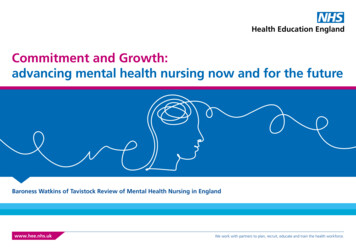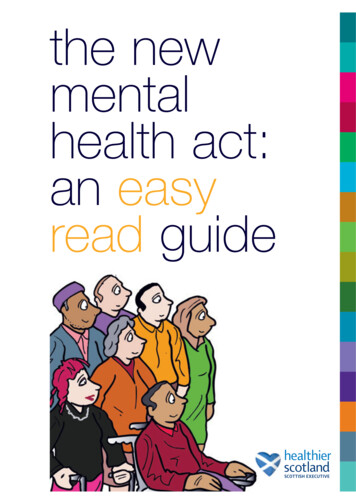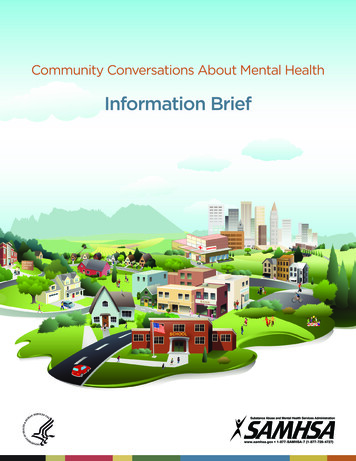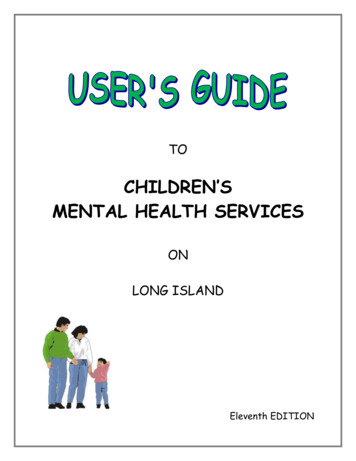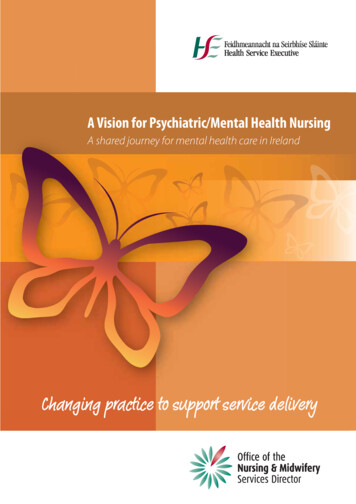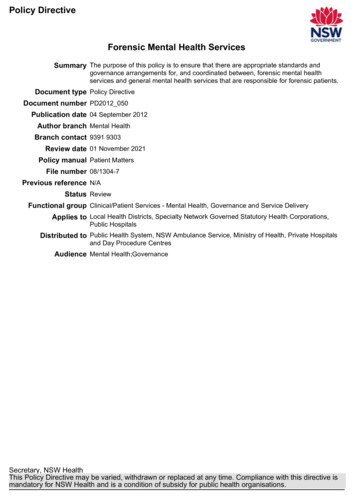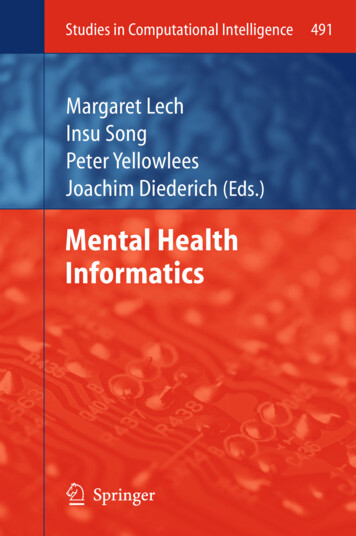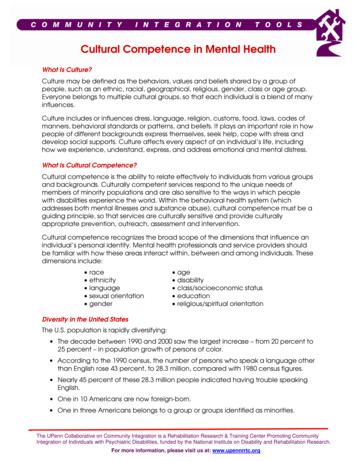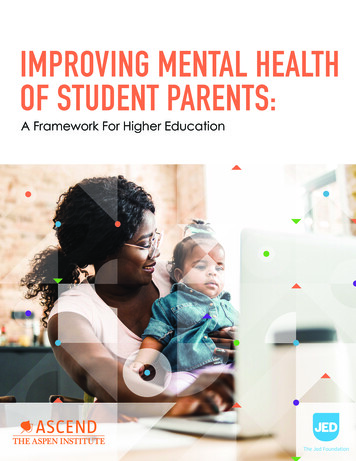
Transcription
IMPROVING MENTAL HEALTHOF STUDENT PARENTS:A Framework For Higher Education
Acknowledgments:The Jed Foundation thanks the many generous reviewers of this framework, whoseadvice and input were invaluable, including Vanessa Coca, Autumn Green, Brian Mitra,and Susan Warfield. We like to thank all the participants at the two convenings that weheld in collaboration with Ascend in August 2020 and March 2021. We are grateful toall of our research participants for sharing their time and insights. We appreciate ourcolleagues at Fluent Research, who collaborated with us on the original mixed-methodsstudy. In addition, we are greatly indebted to our colleagues at Ascend at The AspenInstitute for providing such wonderful guidance along the way. We like to particularlythank Marjorie Sims and David Croom for their tireless support and great insightthroughout this project. Finally, we like to thank all the extraordinary parenting studentswho go through this journey every day and hope that our work can be helpful to them.We thank the Hope Center for College, Community, and Justice for sharing data fromthe #RealCollege Survey with us and acknowledge the generous support provided tothem to conduct the #RealCollege Survey by the Prentice & Alline Brown Foundation,The Annie E. Casey Foundation, Inc., the Bill & Melinda Gates Foundation, GatesPhilanthropy Partners, Imaginable Futures, and the Lenfest Foundation.Ascend at the Aspen Institute would like to thank the Annie E. Casey Foundation, theBezos Family Foundation, and the David and Lucile Packard Foundation for supportingthis groundbreaking effort. This work would not exist without the thoughtful contributionsof the Jed Foundation. In particular, we thank Sara Gorman and Kamla Modi forshepherding the research and analysis.
SUMMARYThe Jed Foundation (JED) is a nonprofit that protects emotional health and prevents suicide for our nation’s teens andyoung adults. In 2020, JED entered into a partnership with Ascend at the Aspen Institute to better understand the mentalhealth needs of parenting students at undergraduate institutions across the country.1 Parenting students representover 20% of the total undergraduate student population. The final output of the partnership is a framework and set ofrecommendations for administrators, faculty, and staff at institutions of higher learning to understand how they can bettersupport the mental and emotional well-being of parenting students. All of the recommendations in this framework link backto mental health, but our approach to mental health is broad and includes many aspects that affect mental health butmay not be thought of as traditionally part of mental health. These aspects include factors such as feelings of belongingand connectedness and the ability (or inability) to satisfy basic needs.In order to ensure that our framework is grounded in the best evidence available, we have undertaken a literature review;an analysis of existing national data on the emotional well-being of undergraduate students, including the Healthy MindsNetwork Study, the American College Health Association’s National College Health Assessment national survey, and theHope Center’s 2020 #RealCollege Survey; and an original mixed-methods research study looking at the unmet needsof student parents. The Healthy Minds Network (HMS) study data from 2020 includes a sample of 46,336 undergraduatestudents enrolled in JED Campus schools across the country and the 2020 American College Health Association (ACHA)data includes a sample of 88,051 undergraduate students enrolled in schools across the country. The sample included 7,290parenting students from the HMS dataset and 5,102 parenting students from the ACHA dataset. In addition, we analyzed2020 data from the Hope Center’s 2020 #RealCollege Survey, including 195,000 undergraduates and 32,000 studentparents. Our qualitative research was conducted in late fall 2020 with 25 student parents, and our quantitative research,conducted in winter 2021, included 1,022 college students at institutions across the U.S. (436 nonparenting students and 586parenting students).1Note that this report focuses exclusively on undergraduate parenting students (also described as students who are parents), not graduate or professional students.An Ascend at the Aspen Institute Publication 1
Data SourceDescriptionYearNumber ofStudents (Total)Number of ParentingStudents (%)Healthy Minds Study(HMS)An annual web-based study examining mentalhealth, service utilization, and student attitudesabout mental health.202046,3367,290(15.7%)National CollegeHealth Assessment(NCHA)An annual, national survey collecting dataon a wide range of health issues amongundergraduate students, including mental healthand substance use.202088,0515,102(5.8%)2020 #RealCollegeSurveyThe nation’s largest survey assessing basic needsof college students. The survey also allows forinsights into diversity and equity, student health,and emergency aid.2020195,00032,000(16.4%)Original QualitativeResearch(in partnership withFluent Research)An asynchronous, online discussion among25 current student parents to gain betterunderstanding of their challenges and needs.2020N/A25Original QuantitativeResearch(in partnership withFluent Research)A nationally representative survey ofundergraduate students, over-sampling forstudent parents, in order to better understandthe challenges and needs of this population,especially in comparison to nonparenting students.20211,022586 parents(436 nonparents)Figure 1: Summary of Data SourcesOverall, we found that parenting students are more likely to face a number of stressors that put them at greater risk formental health issues than nonparenting students. In addition, parenting students consistently and overwhelmingly reportfeeling isolated and disconnected from campus. Given that a sense of belonging is key to positive mental health, thislack of inclusion is another area of risk. They deal with the constant juggling of childcare, employment, and coursework,lack of sleep, continual stress and anxiety, and feelings of guilt. In our original survey research with Fluent Research,43% of student parents reported feeling stressed all or most of the time, 40% reported feeling overwhelmed, 29% reporteddifficulty regulating emotions, 28% reported feelings of depression, and 28% reported a sense of social isolation. More thana third (38%) said that they had considered dropping out of school within the previous 30 days, compared with 25% ofnonparenting students. Among those student parents receiving financial aid (ages 18-45), this percentage that considereddropping out was 50% and among 18-29-year-olds it was 45%. In our qualitative research we discovered some examples ofdetrimental attitudes of faculty in particular and learned about the way in which these negative attitudes make parentingstudents feel unwelcome. Four in 10 student parents describe the experience of attending school while raising a child asextremely or very challenging.2 Improving Mental Health of Student Parents: A Framework For Higher Education
PARENTING AND NONPARENTING STUDENTS CONSIDERING DROPPING OUT OF SCHOOL60%50%50%40%45%38%25%30%20%10%0%Parenting StudentsConsidered dropping out past 30 daysNonparenting StudentsParenting Students Receiving Financial AidParenting Students Ages 18-29We also discovered that parenting students of different ages have different attitudes and experiences. Our researchsuggests that institutions of higher learning would do well to focus efforts to engage and support student parents on youngerparenting students ages 18-24, as these students face particular challenges around poor mental health, substance use, andfeelings of low self-esteem and isolation. On the other hand, older parenting students (ages 25 and older) demonstrated adegree of resilience that was not always evident even in their nonparenting counterparts. These differences between olderand younger parents held up across both two- and four-year institutions. These findings suggest that areas of opportunity forhigher education institutions include initiatives that increase parenting students’ sense of belonging on campus as well asprograms that target younger parenting students. Focusing on changing the attitudes and behaviors of faculty members isalso a high priority.An Ascend at the Aspen Institute Publication 3
KEY BARRIERS AND PERCEPTIONSThe data clearly show that parenting students face a number of unique barriers. Key among them is financial stress. Nearlya quarter (21.3%) of parents in the HMS dataset describe their financial situation as “always stressful” versus only 14.5% ofnonparents. Parenting students are also far more likely to work full time than nonparents.2 Many parenting students are alsoresponsible for more than one dependent at home.3The 2020 #RealCollege Survey documents a wide range of basic needs insecurities that are significantly more commonamong parents than among nonparents. Parenting students are more likely to have been unable to pay or underpaidrent or mortgage in the past 12 months (38% versus 19%); more likely to have not paid the full amount for utilities in the past12 months (43% versus 18%); more likely to have borrowed money from friends or family in the past month to pay bills(45.7% versus 35%); more likely to have gone into collections in the past 12 months (29% versus 9%); and more likely to haveoften worried in the past 30 days that food would run out (19% often true versus 11% often true). The relationship betweenbasic needs insecurity and mental health is complex and bidirectional. Poverty exacerbates feelings of hopelessness and atthe same time depression and other mental health issues can exacerbate barriers and challenges to making ends meet.PAST YEAR BASIC NEEDS INSECURITIES: PARENTING STUDENTS VS. NONPARENTING 0%0%Unable to payor underpaidrent/mortgageSource: 2020 #RealCollegeSurveyHave not paidthe full amountfor utilitiesHave borrowed moneyfrom friends/familyto pay billsParenting StudentsHave gone intocollectionsHave often worriedthat food wouldrun outNonparenting StudentsAccording to the NCHA survey, parenting students report feeling less connected to campus. They are more likely than theirnonparenting counterparts to strongly disagree that they feel like they belong on campus.4 This finding that student parentsthink schools have their best interest in mind might mean that parenting students may respond well to campaigns initiatedby the university to help them feel more connected. These campaigns and efforts may take the form of including theirfamilies in more campus events and helping parenting students find other parenting student peers.218.31% of parents in the HMS dataset worked 36-40 hours per week versus 6.69% of non-parents.338.15% in the HMS dataset report having one child, 30.27% report having two children, 16.6% report having three children, and 14.98% report having four or more.420% of parenting students versus 15% of nonparenting students in the ACHA dataset report strongly agreeing that the university prioritizes health and well-being. 2.72% of parentsstrongly disagree that they feel like they belong on campus versus 1.94% of non-parents.4 Improving Mental Health of Student Parents: A Framework For Higher Education
SENSE OF LIFE PURPOSE AND MEANINGIn a subsequent analysis of data by age (18-24 and 25 and older), younger parents aged 18-24 struggled with feelingsabout their life and future more than their nonparent counterparts. Older parents aged 25 and up had more positivefeelings about their life and future than their nonparent counterparts. To take just one example, nonparents and parents inthe 18-24 age group had similar rates of “agree” and “strongly agree” in response to the statements, “I lead a purposefuland meaningful life” (around 20% strongly agree in both groups) and “I am engaged and interested in my daily activities”(around 30% agree and 11% strongly agree in both groups). By contrast, parents in the 25 and older age bracket weremore likely than nonparents in the 25 and older age bracket to agree or strongly agree with these statements.5 Parents inthe 25 and older age group were also more likely than their nonparent counterparts to strongly agree with the statement,“I actively contribute to the happiness and well-being of others” (31% versus 22%) as well as with the statement, “I amcompetent and capable in the activities that are important to me” (32% versus 26%). While we did not follow up on thesequestions directly, our hypothesis is that parenting in general fosters a sense of purpose and competence that is more likelyto appear when children are a bit older and parents are out of the most time-intensive stage of parenting. Thus we see thisgreater sense of purpose in older parenting students who have older children for the most part. Even if some of these olderparents have young kids, it is still possible that the years they waited to have children may have allowed them to get abetter sense of themselves and gain confidence and self-understanding that may result in a more positive outlook.PARENTING STUDENTS' MEANING AND PURPOSE BY AGE 0%I lead a purposeful and meaningful lifeParenting Students 18-245Nonparenting Students 18-24I am engaged and interested in my daily activitesParenting Students 25 Nonparenting Students 25 HMS dataset, 32% of parents aged 25 and older strongly agree with the statement, “I lead a purposeful and meaningful life” versus 22% of non-parents, and 58% of parents aged 25and older agree or strongly agree with the statement, “I am engaged and interested in my daily activities” versus 50% of non-parents.An Ascend at the Aspen Institute Publication 5
FEELINGS ABOUT LIFE PURPOSE AND MEANING: PARENTING VS. NONPARENTING STUDENTS AGE 25 35%32%32%31%30%25%26%22%22%20%15%10%5%0%I lead a purposeful andmeaningful lifeI actively contribute to thehappiness and well-being of othersParenting Students 25 I am competent and capable inthe activites that are important to meNonparenting Students 25 6 Improving Mental Health of Student Parents: A Framework For Higher Education
MENTAL HEALTH AND SUBSTANCE USEParenting status seems to be associated with severalmental health and emotional well-being advantages.Parenting students report being less likely to have seriouslyconsidered attempting suicide than nonparents.6Anecdotal evidence suggests that parenting studentsview having a child as a turning point in a path that mayhave previously included drug and alcohol misuse. Infact, drug and alcohol misuse is almost completely absentin this population. The lack of substance misuse may beprotective against other mental health issues.Recalling the last time that they drank alcohol, only 16% ofparenting students report having been drunk versus 40% ofnonparenting students. Parenting students were also lesslikely to report having 3-5 drinks7 or 6-10 drinks.8 Parentingstudents were significantly less likely to report having hadfive or more drinks (for males) or four or more drinks (forfemales) in the past two weeks.9 Parenting students wereabout half as likely as nonparenting students to reportdoing something they later regretted while under theinfluence of alcohol. Student parents were more than halfas likely to report blacking out from alcohol consumption.PROBLEMATIC DRINKING BEHAVIORS: PARENTING STUDENTS VS. NONPARENTING %0%Drunk at last alcohol consumption3-5 drinks at last alcohol consumptionParenting Students6HMS dataset, 11.5% parents versus 14.7% non-parents7ACHA dataset, 25.15% versus 35.91% of nonparenting students8ACHA dataset, 6.96% versus 15.47% of nonparenting students9ACHA dataset, 31.42% versus 53.88% of nonparenting students6-10 drinks at last alcohol consumptionNonparenting StudentsAn Ascend at the Aspen Institute Publication 7
On the other hand, parenting students seem to face otherbarriers to receiving help when they do have a mentalhealth issue. Overall, parenting students are less awarethan nonparenting students of mental health outreachefforts on campus.10 In addition, parenting students aremore likely than nonparenting students to report havingtrouble paying for mental health care, with 6.3% parentsversus 4.9% nonparents reporting that it is “somewhatdifficult,” 4.2% parents versus 2.7% nonparents reporting“difficult,” and 5% parents versus 2.7% nonparentsresponding “very difficult.” Campus counseling servicesare often not equipped to understand the complexity oflife stressors faced by nontraditional parenting studentsand sometimes these students opt for off-campuscare or no care as a result of feeling misunderstood.Compounding matters is the fact that many communitycollege campuses do not offer substantive health serviceson campus and students at community colleges are lesslikely to be insured than students at four-year institutions.11And while most student parents cope well with theextraordinary challenges that they face, and even saythat the overall experience of being a student parent ispositive, a sizeable minority (roughly one quarter to onethird) of these students suffer adverse impacts on theiremotional and mental health, including panic attacks andsevere anxiety, which often lead to thoughts of droppingout of school. Student parents experiencing these moresevere emotional and mental health challenges aredisproportionately female, non-White, and recipients offinancial aid.Additionally, further analysis of Hope Center data suggest a clear relationship between multiple forms of basic needsinsecurity and depression or anxiety. Parents who had difficulty paying rent, who had been homeless in the past 12 months,who worried about whether food would run out before they had money to buy more, and who had difficulty paying bills,all had significantly higher rates of depressive and anxiety symptoms than parents who did not experience these stressors.These stressors are quite common among parenting students and these data indicate that this population is at risk ofsignificant mental health problems as a result.10HMS dataset, 46.65% parents versus 57.47% non-parents report being aware of these efforts on campus.11Institute of Women’s Policy Research, “Improving Success in Higher Education through Increased Access to Reproductive Health Services.” January 2020. Accessed May 6, ERH-Higher-Ed-brief.pdf.8 Improving Mental Health of Student Parents: A Framework For Higher Education
ACADEMIC BARRIERS AND BEHAVIORSIn the academic realm, the data suggest that parenting students struggle more with their academics, yet seek outacademic support more frequently than nonparents. In response to the question, “How has it been to adjust to theacademic demands of college since you began as a student at your school?” 5.71% of parents said the adjustment wasvery easy (versus 8.84% of nonparents), 11.43% of parents said the adjustment was easy (versus 16.59% of nonparents),and 38.57% of parents said the adjustment was somewhat difficult (versus 30.39% of nonparents).12 Nearly a fifth of parents(19.44%) stated that it was difficult to manage time effectively since starting as a student (versus 14.27% of non-parents) and11.11% said that time management was very difficult (versus 5.68% of non-parents). We certainly heard about difficulties withtime management and juggling multiple responsibilities in our qualitative research.At the same time, data suggest that parenting students seemed to seek out academic support more frequently than theirnonparent counterparts. Close to double the number of parenting students (6.48%) report interacting with academicadvisors two to three times per week versus 3.98% of nonparents; 2.78% report interacting with academic advisors everyday or nearly every day versus 1.19% of nonparents; and 11.11% report interacting with academic advisors once per weekversus 3.98% of nonparents. Parenting students also report more frequent contact with faculty during office hours.13 Finally,parenting students report interacting with faculty more frequently outside of class and office hours than their nonparentingcounterparts.1412HMS dataset13HMS dataset, 5.56% of parents reported interacting with faculty during office hours every day or nearly every day (versus 0.53% of non-parents) and 14.81% of parents reportedinteracting with faculty during office hours once per week (versus 7.16% of non-parents).14HMS dataset, 15.74% of parents reported this kind of contact two to three times per week (versus 9.68% of non-parents) and 4.63% reported this kind of contact every day or nearlyevery day (versus 0.66% of non-parents).An Ascend at the Aspen Institute Publication 9
SUBGROUP ANALYSESWhen we analyzed data broken down by age, we had some additional interesting findings that help us focus ourrecommendations and interventions. Overall, student parents seemed more protected from mental health symptoms whencompared with their same-age nonparent counterparts. While rates were very similar for parents and nonparents aged 1824, student parents aged 25 and older were more likely to respond “not at all” to both “Over the last two weeks, how oftenhave you been bothered by: Little interest or pleasure in doing things” (44% parents versus 36% nonparents) as well as “Overthe last two weeks, how often have you been bothered by: Feeling down, depressed or hopeless” (43% parents versus 36%nonparents).15 Significant discrepancies exist in problematic drinking for the younger parenting student age group versusolder parenting students. While older parenting students report almost no instances of drinking more than two drinks, almost15% of younger parenting students report drinking 6-10 drinks the last time they drank. Younger parenting students tend tohave lower confidence in themselves and believe they are less resilient than older student parents. For example, youngerparents are nearly twice as likely to strongly disagree with the statement, “I am able to adapt when changes occur” ascompared to older parenting students. The same is true of strong disagreement with the statement, “I tend to bounceback after illness, injury, or other hardships.” Younger parents are three times as likely as older parenting students to reporthaving felt nervous all the time in the past 30 days, four times as likely to report feeling hopeless, and five times as likely toreport feeling worthless. Younger parents are almost twice as likely as older student parents to report feeling that they lackcompanionship, twice as likely to report feeling left out, and almost twice as likely to report feeling isolated. Younger parentsare also 1.5 times more likely than older student parents to report having made a suicide attempt and about twice as likelyto report having thought “very often” in the past year about killing themselves. These “protective” findings in older studentparents in both surveys suggest the possibility that older student parents might serve as good mentors to younger studentparents who seem to struggle more.PROBLEMATIC DRINKING: PARENTING STUDENTS 25 VS. NONPARENTING STUDENTS 18-2480%69%70%60%50%52%40%30%20%13%10%0%2 drinks of less at last alcohol consumptionParenting Students 18-24156%6-10 drinks at last alcohol consumptionParenting Students 25 HMS dataset10 Improving Mental Health of Student Parents: A Framework For Higher Education
PAST 30 DAYS MENTAL HEALTH PROFILE: PARENTING STUDENTS 25 VS. NONPARENTING STUDENTS 18-2414%12%12%10%8%6%6%4%4%4.6%2%1.6%2%0%Nervous all the timeHopeless all the timeParenting Students 18-246-10 drinks at last alcohol consumptionParenting Students 25 2020 #RealCollege Survey data suggest that older student parents were doing better than younger parents in other keyareas of their lives that may relate to mental health. In the academic realm, older student parents were more likely thanyounger student parents to be getting As (37% versus 23%) and less likely to be failing (1.9% versus 3.04%). Younger parentsalso seemed to struggle more with basic needs, including being more concerned about running out of food (24.5% versus18%); not being able to afford to eat balanced meals in the past 30 days (22.7% versus 15%); and experiencing morehousing instability (10% of younger parents have moved twice in the past 12 months versus 3% of older parents). Maritalstatus is worth noting an important difference between younger and older student parents that contributes to differentialsin their well-being and basic needs security. Older student parents are much more likely to be married than youngerstudent parents. Marriage often means greater income, better parenting supports, and more free time to study, amongother advantages.BASIC NEEDS INSECURITY OF PARENTING STUDENTS BY AGE rned about running out offood past 30 daysSource: 2020 #RealCollegeSurveyUnable to afford balanced mealspast 30 daysParenting Students 18-24Experienced housing instabilitypast 12 monthsParenting Students 25 An Ascend at the Aspen Institute Publication 11
RECOMMENDATIONS FOR COLLEGES AND UNIVERSITIES TO SUPPORT THEMENTAL HEALTH OF STUDENT PARENTSSome of our findings are not entirely surprising, while othersare not what we might expect. For example, the findingthat parenting students face increased financial stressorsand difficulty accessing and paying for mental health careservices is not unexpected. We did find some interestingprotective factors that might form the basis of furtherinterventions to protect the mental health of parentingstudents. For example, parenting students seem to havemore contact with faculty and academic support servicesthan nonparenting students. As a result, training campusstaff members to recognize and help parenting studentswho might be struggling with their mental health mightmake sense. Educating faculty and staff on the uniquestressors that face parenting students and ways to helpmight be particularly effective. As a basic first step, staffand faculty should know to ask students if they are parents,recognizing that many student parents do not offer thisinformation voluntarily due to a fear of being treateddifferently from other students. If faculty and staff do not askif students have children, they will not fully appreciate thestressors some students are facing. Overall, data show somerich opportunities for nuanced interventions that truly takeinto account the nature of the problem. This examinationhas unearthed an important distinction between olderand younger parenting students, with younger parentingstudents seemingly in a more difficult situation. This insightespecially should help guide how interventions in thestudent parent population are structured.seeking care than their nonparent counterparts. Therefore,undergraduate institutions must have specific strategies tosupport these students.The following recommendations are meant to helpundergraduate institutions prioritize the unique needsof parenting students. This population constitutes asignificant portion of the overall student body (over 20%),and evidence suggests that student parents face uniquechallenges. Data suggests that they may be more at riskof mental health issues and may face greater barriers toThe unique stressors faced by parenting students are realand counselors need to be aware of these stressors to servestudents effectively. In our research, we uncovered thefollowing major sources of stress among parenting studentsthat are in most cases unique to this population:16Recommendation #1: Train counselors and otheron-campus mental health providers on unique stressorsfaced by student parents and specifically in traumainformed care. Train faculty and staff in understanding andbeing sensitive to the unique stressors faced by parentingstudents to allow for a culture shift whereby parentingstudents are fully factored into professorial and staffdecisions and policies.In a convening of college mental health experts andstudent parent representatives in August 2020, participantsrepeatedly raised the issue of counselors and other mentalhealth professionals on college campuses having limitedknowledge of the unique stressors and experiences ofparenting students. This theme recurred in our qualitativeresearch as well as in the literature review. Parentingstudents reported rarely using on-campus mental healthresources or feeling misunderstood by counselors whenthey did. In one study conducted by Generation Hope in2020, less than one-third of parenting students reportedfeeling comfortable accessing mental health services oncampus.16 College counseling centers should also includeclinical social workers and others who have family andmarital training and should be sure to be connected withcommunity resources. Parenting students were much more likely thannonparenting students to have a history of trauma.Generation Hope, “National Student-Parent Survey Results and Recommendations: Uncovering the Student-Parent Experience and Its Effect on College Success.” May 2020.Accessed May 7, 2021: 1914/GH %23StudentParentSuccess ReportFinal.pdf.12 Improving Mental Health of Student Parents: A Framework For Higher Education
Trauma might relate to rejection by family (especiallyin the case of students who were teen parents), sexualassault and domestic violence, and trauma relatedto basic needs insecurities such as homelessness. Thisrealization is important, as it suggests that counselorsshould be looking out for trauma responses andinquiring about traumatic events when treatingparenting students.17 Parenting students face basic needs insecuritiesat much higher rates than nonparenting students.
3 38.15% in the HMS dataset report having one child, 30.27% report having two children, 16.6% report having three children, and 14.98% report having four or more. 4 20% of parenting students versus 15% of nonparenting students in the ACHA dataset report strongly agreeing that the university prioritizes health and well-being. 2.72% of parents


